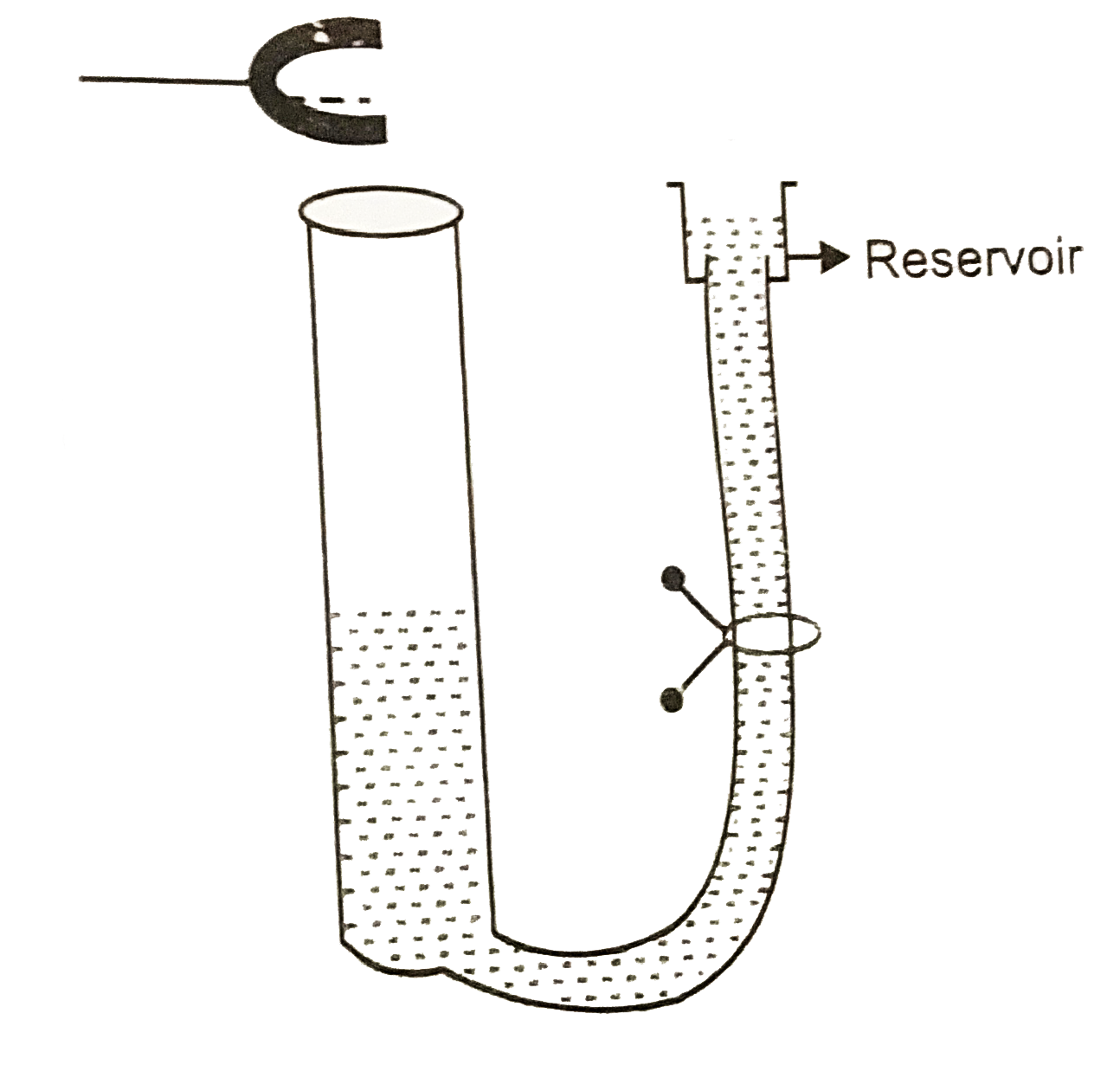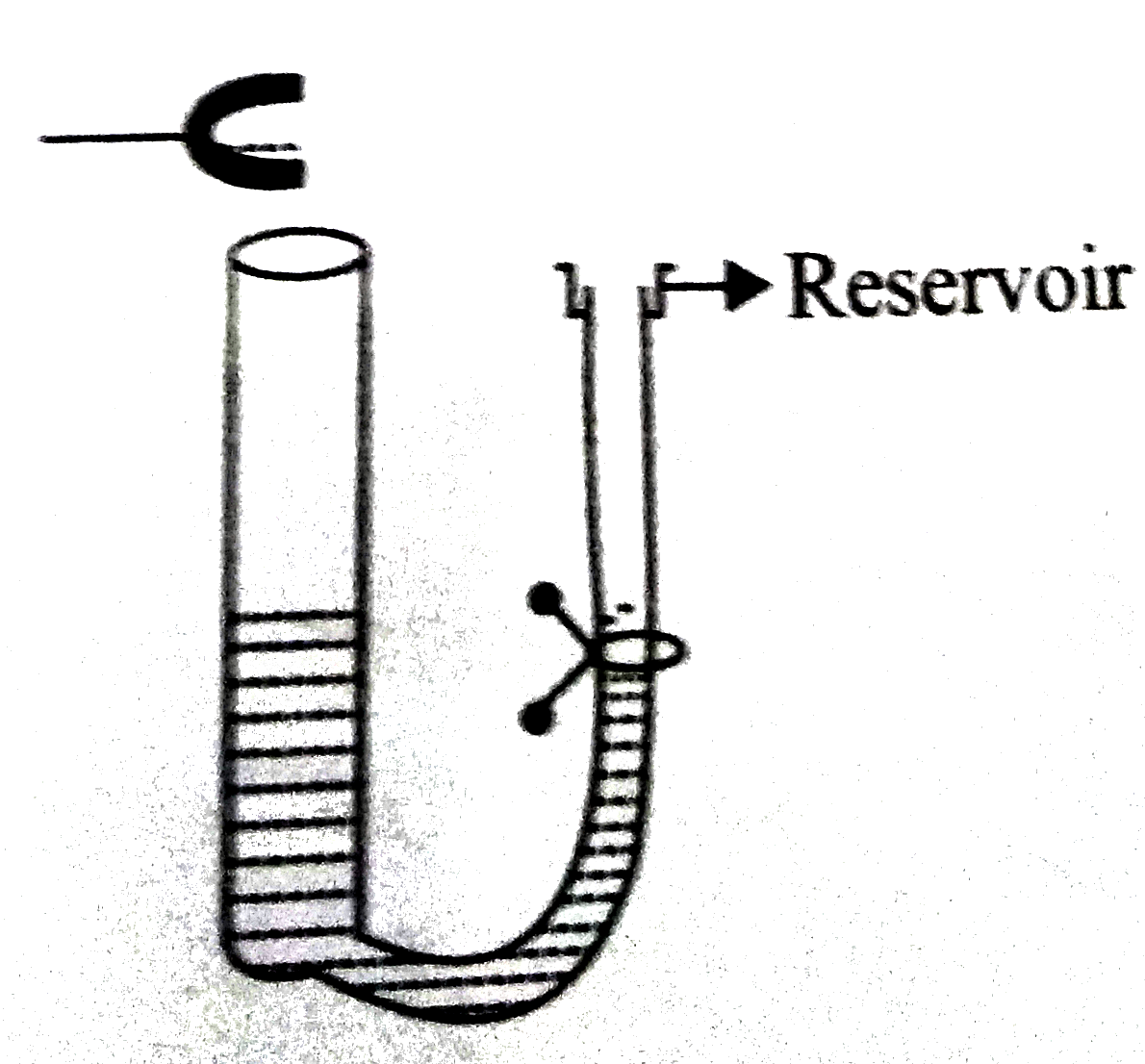A tuning fork vibrating with a frequency of 512 Hz is kept close to the open end of a tube filled with water , figure. The water level in the tube is gradually lowerd. When the water level is 17cm below the open end, maximum intensity of sound in heard. If the room temperature is 20∘C, calculate
(a) speed of sound in air at room temperature.
(b) speed of sound in air at 0∘C
(c) if the water in the tube is replaced with mercury, will there be any difference in your observations?

Here, v=512Hs,l1=17cm
(a) From v=υt4l1
υt=v(4l1)=512(4×17100)m/s=348.16m/s
(b) υ0=υt√T0T=348.16√273+0273+20=336.1m/s
(c) There will be no change in resonance length when water is replaced by mercury as it serves as reflector of sound waves only. The intensity of sound may increase because mercury beign denser than water will reflect sound waves more completely.
Topper's Solved these Questions
- OSCILLATIONS AND WAVESBOOK - PRADEEPCHAPTER - OSCILLATIONS AND WAVESEXERCISE - Long Answer Questions
33 Videos
- OSCILLATIONS AND WAVESBOOK - PRADEEPCHAPTER - OSCILLATIONS AND WAVESEXERCISE - Advanced Problems For Competitions
20 Videos
- OSCILLATIONS AND WAVESBOOK - PRADEEPCHAPTER - OSCILLATIONS AND WAVESEXERCISE - Very Short Answer Questions
99 Videos
- MATHEMATICAL TOOLSBOOK - PRADEEPCHAPTER - MATHEMATICAL TOOLSEXERCISE - Fill in the blanks
5 Videos
- PHYSICAL WORLD AND MEASUREMENTBOOK - PRADEEPCHAPTER - PHYSICAL WORLD AND MEASUREMENTEXERCISE - Competiton Focus Jee Medical Entrance
18 Videos
Similar Questions
A tuning fork of frequency 250 Hz is vibrating at one end of a tube as shown in the figure. If maximum sound is heard at the other end, then the velocity of the waves will be

View SolutionA tuning fork whose natural frequency is 440HZ is placed just above the open end of a tube that contains water. The water is slowly drained from the tube while the tuning fork remains in place and is kapt vibrating. The sound is found to be echanced when the air column is 60cm long and when it is 100cm long . Find the speed of sound in air.
View Solution
Knowledge Check
A tuning fork vibrating with a frequency of 500 Hz is kept close to the open end of a tube filled with water, as shown in figure. The water level in the tube is gradually lowered When the water level is 17 cm below the open the open end, maximum intensity of sound is heard. If the room temperature is 20∘ C, the speed of sound in air at the temperature is
 A330ms−1B340ms−1C350ms−1D360ms−1
A330ms−1B340ms−1C350ms−1D360ms−1A vibrating tuning fork is held over a water column with one end closed and the other open. As the water level is allowed to fall, a loud sound is heard for water levels separated by 17 cm. If the speed of sound in air is 340 m/s, the frequency of the tuning fork is:
A500 HzB1000 HzC2000 HzD5780 HzVibrating tuning fork of frequency v is placed near the open end of a long cylindrical tube. The tube has a side opening and is fitted with a movable reflecting piston. As the piston is moved through 8.75 cm, the intensity of sound changes from a maximum to minimum, if the speed of sound is 350 m/s. Then v is
 A500 HzB1000 HzC2000 HzD4000 Hz
A500 HzB1000 HzC2000 HzD4000 Hz
Find the frequency of the third overtone of an air column vibrating in a pipe closed at one end. The length of the pipe is 30cm and the innter diameter of the pipe is 2 cm the speed of sound in air at room temperature is 350 m/s .
View SolutionA resonance tube is resonated with tuning fork of frequency 512 Hz. Two successive lengths of the resonated air column are 16.0 cm and 51.0cm. The experiment is performed at room temperature of 40∘C. Calculate speed of sound at 0∘C and end correction.
View SolutionA tuning fork of frequency 341 Hz is vibrated just over a tube of length 1m. Water is being poured gradually in the tube. What height of water colume will be required for resonance?Speed of sound in air is 341 m / s.
View SolutionVibrating tuning fork of frequency n is placed near the open end of a long cylindrical tube. The tube has a side opening and is fitted with a movable reflecting piston. As the piston is moved through 8.75cm, the intensity of sound changes from a maximum to minimum. If the speed of sound is 350m/s. Then n is

View SolutionA tuning fork of frequency n is held near the open end of tube, the tube is adjusted until resonance occurs. If the two shortest lengths to produce resonance are L1andL2 , then the speed of the sound is
View Solution
